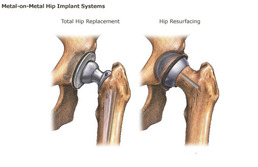The human hip joint is naturally formed by the top of the thigh bone, called the femur, meeting the socket of the pelvic bone, called the acetabulum. The top of the femur naturally fits into the acetabulum since it is shaped like a ball. The bones are also assisted by the cartilage the hip bone has, the cartilage cushions and protects the bones. The
most common reason someone can choose to undergo hip replacement surgery is hip arthritis, this is were the cartilage is worn down to where the bones inside the hip begin to rub against each other, causing a person pain.
Hip replacement surgery is normally the next logical step when hip arthritis begins to set in. Hip Replacement surgery is done to over 270,000 people each year, these surgeries are done to relieve pain, return mobility, and remove stiffness from injured hips of these patients. The hip replacement surgery happens in two parts, first the top of the femur or femoral stem is removed and replaced with an artificial ball, afterwards the acetabulum is replaced with an artificial shell where the ball will be placed.These two artificial parts are meant to simulate the body’s natural movement as closely as possible.
It is expected as with any surgery that there will be a short recovery time as the body heals and starts to adapt to the new artificial implants. Some bodies however can actually reject the implants and cause more pain to the patient. Implant rejection is not the only side effect one needs to look out for during surgery, other common side effects to surgery include: bone dislocation, leg length discrepancy, failure to improve all pain, bone fracture, change in component position, infection, and even loosening and dislodging of the implant.
However, once surgery is done and the body has healed from the procedure there are also other potentially harmful side effect the patient needs to look out for. However, failure of the hip replacement system itself is what the patient needs to be most wary of. A prime example of this is the DePuy Pinnacle hip replacement system, which is a newer hip replacement system by DePuy Orthopaedics Inc., this hip replacement system has a 15% failure rate amongst its recipients, which is unusually high.
The high failure rate of the DePuy Pinnacle Hip replacement system has actually caused many of the injured to file a
DePuy Pinnacle Lawsuit against DePuy. If you are a recipient of a Pinnacle Hip replacement system and think it is starting to fail you should visit a DePuy Pinnacle Lawyer about your legal options. Many Lawyers will give a free consultation and usually do not charge unless your case receives compensation.




 RSS Feed
RSS Feed